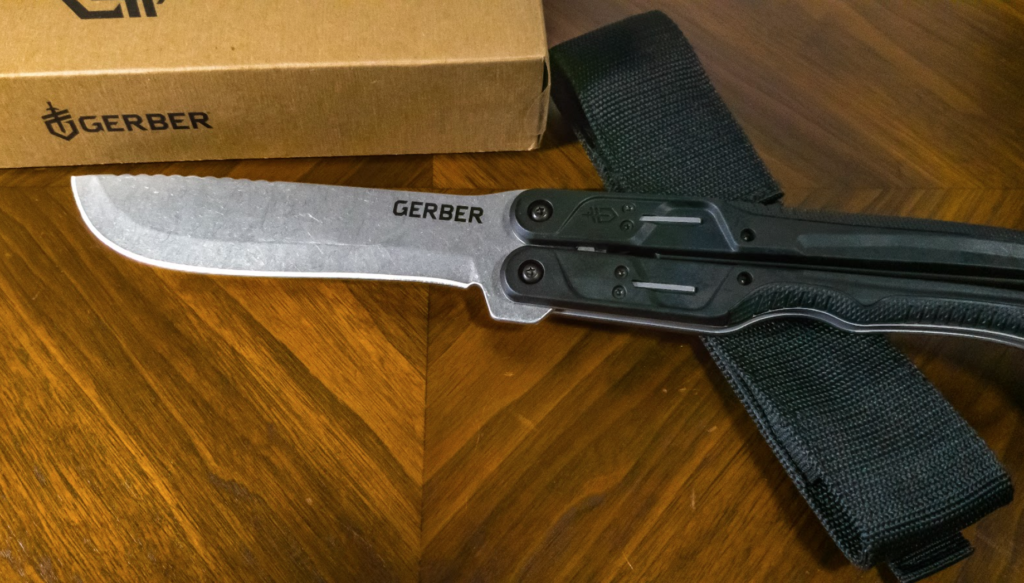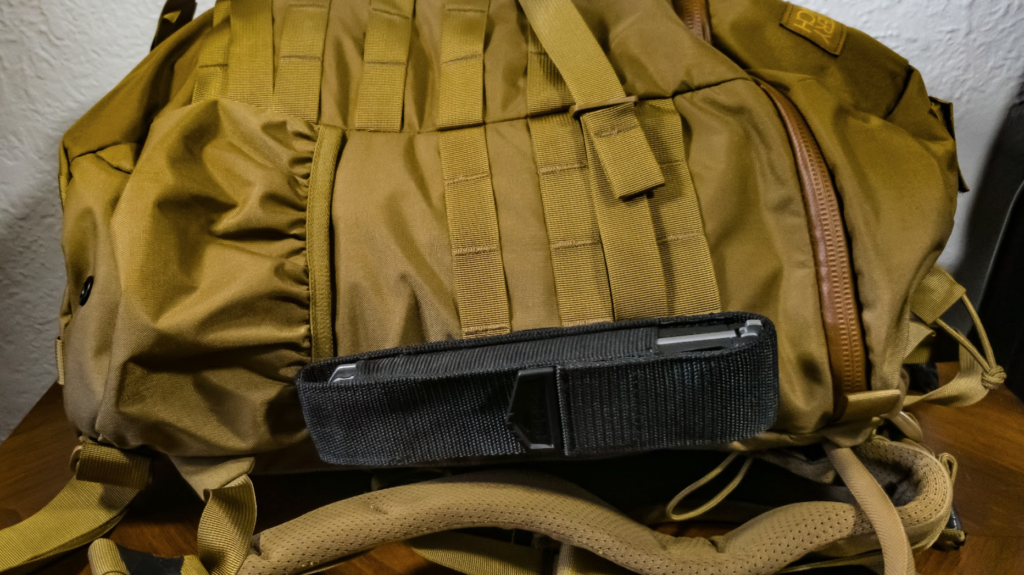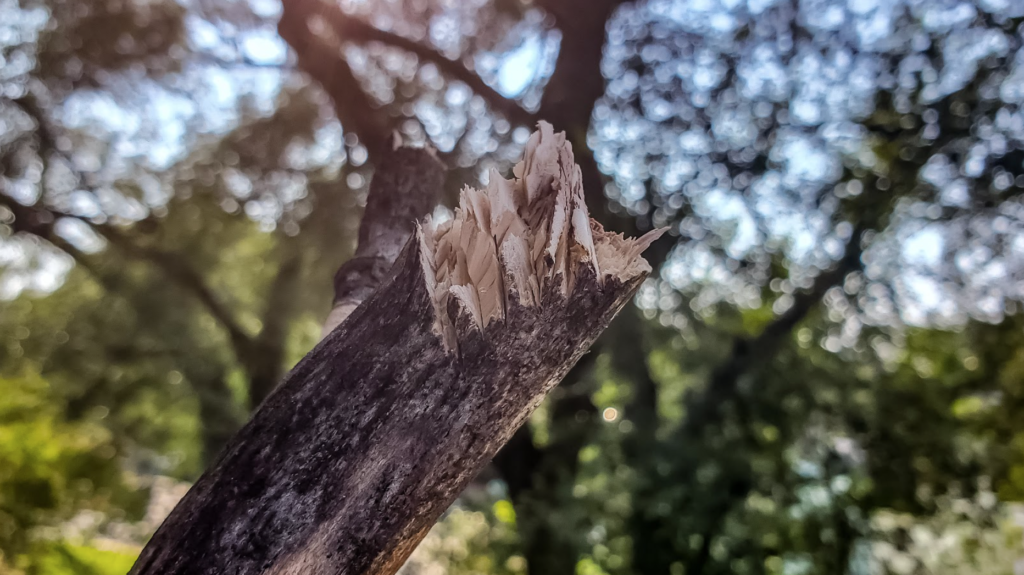I have a confession to make: I really didn’t want to write this review.
I thought this was going to be something that my friends and I could snicker at on the internet, and then I could write another trashy article about “har har giant butterfly knife stupid, ‘studied the blade’ joke here, Gerber bad, bottom text.” But no, apparently this thing is actually a decent tool and functions fairly well as a short machete. Granted, it’s still flawed, it’s still a Gerber, and it’s still absolutely bonkers-looking, but it’s not as flawed, as bonkers, or as Gerber-esque as I had hoped. It’s just as well, I suppose, because I can’t even use a regular butterfly knife safely, let alone one that’s 15 inches in overall length. So here I am, writing a serious knife review about what amounts to the Mothra of butterfly knives.
The Gerber DoubleDown is a folding machete, manufactured by Gerber as part of their Made in America line of knives and tools. As mentioned above, it strongly resembles a giant butterfly knife, save for one feature: the handles lock and cannot be opened with one hand. This is likely due to a combination of anti-butterfly knife laws in various locales and safety concerns and presents what seems like, at first glance, a neutered butterfly knife and a cheap cash grab. With all this being said, I can’t ignore the fact that this thing does exactly what it says on the box, which is to serve as a compact folding machete that you can keep anywhere in your personal belongings.
The Gerber Doubledown is, at its core, a 420HC folding machete for double the price of a fixed-blade option of the same material. Gerber makes other machetes of 420HC steel, as do many companies, but most average $70-80, whereas the DoubleDown is no less than $123 from authorized dealers. The folding mechanism has to be sturdy to withstand the heavy use that you’d expect from a machete, but the question is whether you’re paying for the materials, mechanism, and build quality, rather than paying for the novelty of something that looks like an oversized balisong. Today, I’m here to find that out.
Blade length: 6.75 in
Weight: 18 oz
Material: 420HC stainless steel (blade)
Unboxing
The Gerber DoubleDown comes in a simple brown cardboard box that features the Gerber logo, a white barcode and SKU label, and houses an internal cardboard tray. In the tray is a multi-lingual manual, warranty information, and the knife itself in a nylon sheath. The sheath is a very sturdy black MOLLE pouch, featuring double-layered nylon, elastic sides, and a Velcro-closed flap with a hard rubber tab, signed with “Gerber.” Overall, the sheath is durable but simple, with the double-layered portion one continuous piece of material with the elastic sides and MOLLE webbing sewn on and featuring a “Made in China” tag. The sheath fits the knife tightly, and the flap fastens securely. However, this is a fairly tall sheath, so I don’t foresee this being something that you keep handy on your plate carrier for jungle warfare training; rather, it’d be a handy companion webbed onto your backpack that you or a buddy could access for dense vegetation.
The butterfly knife machete itself features a 6.5-inch blade that folds into steel-lined handles with hard plastic grip scales. The handle features Gerber’s “quad lock” system to prevent this from becoming a true butterfly knife. At the base of the knife is a lever that, on a normal butterfly knife, would secure the handles together after opening, but on the DoubleDown is kind of an afterthought in light of the quad-locking handles and doesn’t even function properly in the open configuration. This is also not a light knife at all, weighing in at a whopping 1.13 pounds, which is really heavy when compared to most knives with this kind of blade length. This is a great thing while swinging it against brush, but a hindrance when it comes to cutting weight for a long trek where you’re cutting the proverbial toothbrushes in half.

Opening the knife is incredibly finicky and is my least favorite aspect of the DoubleDown, even if it is less hazardous to my fingers than a standard butterfly knife. You have to pinch two tabs on each side, and make sure that you get the pressure exactly correct, or else the geared opening hinges will seize up and not function, which can take several tries when trying to open the DoubleDown in a hurry. This is made worse if you’re wearing gloves. I’d really prefer if these tabs were larger and had some sort of wider surface that ensured that you pressed them fully every time. The blade locks in three different positions: fully closed, fully open, and partially open. If you don’t maintain constant pressure while opening the blade, the opening cycle will get stuck in this middle position. I speculate that this may be another step to prevent this from legally being considered a butterfly knife, since this ensures that you cannot, under any circumstance, open this with one hand. Once open, the lever at the base doesn’t lock into place fully, and just…sits there. When closed, you have to slightly open the handles to fit the lever into the notch, taking advantage of the margin of error that the handles have in terms of fitment. Finally, the liners are solid on the outside, which could prevent dirt infiltration.
In terms of handle ergonomics, the design is overall quite good, with user-friendly features that make this a fairly capable machete. For starters, the plastic grip scales fit very well into the hand, and are even molded in a way that will help you swing the machete better. The DoubleDown has a front-heavy design, and this is deliberate, given that this is a specifically hacking-focused tool and not some elegant rapier for dueling. This is accomplished by placing the grip at the base of the handle, having the balance point just above the highest point on the grip, which allows the weight of the blade to carry itself through whatever brush that you’re slicing through. Effectively, this thing hits like a much larger machete, while also being compact and foldable.
The blade really sells the whole “compact machete” feel and fulfills the purpose of the DoubleDown perfectly. This is a slightly recurved plain edge, featuring a stonewashed finish, batoning jimping, and an ever-so-slight drop point, all rendered in that mainstay of basic knifemaking, 420HC. This is displayed on the blade in a plain black printed font, along with a proud “Made in USA” and the Gerber typeface logo on the opposing side, along with a serial number. The blade is of a convex grind, and features a very even and bright edge that feels very sharp, but more to that in the testing portion. When running my thumbnail across the edge, I didn’t feel any kind of burrs along the edge, which suggests a consistent edge. Is $137 a bit much for 420HC steel? Sure, but it’s not like I’m feeling ripped off upon opening and initial inspection.

How we tested the Gerber DoubleDown
Every knife test with me begins with seeing if the blade in question slices paper along the bias, and whether it shaves hair. I usually follow this with a corrosion test and some sort of edge retention test, but I think we’re going to shake it up a bit today with this one, given its intended application. This is a machete, not a pocketknife, so we’re going to go straight from seeing if Gerber did a good job with the factory edge into environmental testing, including the usual corrosion, but with the added dimension of hacking and batoning strength tests.
The sharpness test yielded much better results than I expected for what amounts to a brute force hacking tool, but still much less impressive than I’ve seen in other knives of similar blade lengths. The blade was able to slice through paper from edge to edge, but there was some minor hitching. Whether this was due to uneven sharpening or the fact that the blade is pretty thick, I’d say this was a pretty rough start. However, when I tested how it shaved the hair off the back of my hand, it performed about how I’d expect a knife in this price point, which is to say that it shaved the hair, but it required several passes. Even though I’d call this performance less than stellar, when put in perspective, it’s not unusually bad.

In terms of hacking capabilities, the DoubleDown is in its element and performs better than your hardware store machetes. The blade is made of 420HC steel, which is hard enough to hold an edge while also being soft enough to resharpen in the field with a whetstone, if necessary. Not only can this thing chop through branches and underbrush, but it’s also a fairly capable tool for stripping trees to use for making shelters, and even features jimping on the upper spine of the blade for batoning logs. Using proper technique, which is to say, coming in at an angle to chip away at it, I was able to whack through a one-inch poplar branch in only a few slices. Dried sticks of the same size, as if for a fire, took a little longer. In spite of the large size, whittling a stick to a point was doable, if a little clumsy, given that there’s no provision on the handle for getting a higher, more precise grip. But that’s not really what the DoubleDown is made for. I wasn’t able to test batoning, so to compensate, I put the DoubleDown in some vise grips and hit it with a hammer several times near the hinge and closer to the tip to see if the blade breaks under blatant abuse. It survived there with only some minor scoring on the blade, which didn’t show up as much due to the stonewash finish blade, which already has the appearance of being scratched and scraped.
In terms of corrosion, well, it’s 420HC. This wasn’t going to go well. This isn’t a maritime knife, but as a way to test the oxidizing potential of the blade, I pulled out the salt test, which I’ve changed to be water dribbled on the blade to form droplets, that I then add salt over, and then scrub into the blade to score and damage any sort of clear coat or finish that the manufacturer may have applied to enhance the blade’s corrosion resistance. I then put the wet and salty DoubleDown out in the open air, which today was 98 degrees Fahrenheit with 81 percent humidity. Within two hours, corrosion had formed on the edge of the blade and was starting to form even on the stonewashed blade finish. In addition, the salt had permeated the hinges of the knife, giving it a very gritty feeling upon opening. I didn’t even let the DoubleDown complete the usual 12-hour corrosion test because rust on the blade within two hours is honestly enough to let me know that this is a knife that needs to be cleaned thoroughly and often.

What we like about the Gerber DoubleDown
I was really expecting this to be a joke item that was just wildly excessive and trying to capitalize on the mall ninja market, but I was so wrong. The Gerber DoubleDown works as a machete, giving you 6.5 inches of blade that folds into a compact form factor for carrying and storage. The build quality is acceptable, the blade steel and edge are in line with most of Gerber’s Made in America line, and overall it’s fairly safe to use, despite having a superficial resemblance to a butterfly knife. It’s a fine tool, it’s slightly cooler than a normal machete, and if you want to spend the cash for what you’re getting, it’ll serve you well in its intended role.
What we don’t like about the Gerber DoubleDown
Putting aside the fact that I was really hoping that this would be actually batshit and be a gigantic butterfly knife, this thing is still going to classify as “a lot” in terms of cost for most people, given that at the end of the day, you’re paying over $100 for a 420HC Gerber, when the arguable king of 420HC, Buck Knives, charges $100 on the dot for a 6-inch blade of the same material, albeit in a fixed-blade package. The opening mechanism, which is likely what makes this cost more than average, is finicky and difficult to manipulate under duress, and the latch at the base of the grip doesn’t even properly work in the open position. Personally, I’d just take an Esee 6 or pay a little extra for the bubba-as-fuck Buck 124. This thing just isn’t my cup of tea.
Verdict
If the appeal of a foldable, decent quality, and capable machete is your kind of thing, the Gerber DoubleDown is a good option. It delivers a sturdy blade that swings and cuts like a far larger machete, all with an added element of style. Mechanical gripes aside, it’s not like this is as catastrophically bad as my last foray into the world of Gerber, and I’m sure that if having a compact machete was more present in my Maslow’s Hierarchy of Needs, I’d give this thing a second look. As eccentric as the DoubleDown’s construction is, it’s honestly a very sober, functional design that’s flawed in construction, but reliable when you need it to do what machetes do best.
Saved rounds
The choice to go with a stonewash finish was a good one, given the high-impact and high-wear uses that most people pull out a machete for. You’ll really have to keep up on your blade maintenance though, as 420HC is not stainless in any sense of the word. Make sure you regularly clean the blade and keep the hinges lightly lubricated, with a dry lube if possible so that you don’t attract more dust and corrosion.
You might be wondering why I’m testing a decidedly terrestrial knife with salt water corrosion, especially since that’s not something you’ll encounter inland. I’ve got three reasons: to accelerate the rust process, to test the blade’s performance in salty environments like saltwater marshes and coastal forests, and to compensate for the fact that I can’t test this thing against some of the more exotic corrosion hazards that you might encounter in the wild. It’s unrealistic for me to take every knife that I test out for weeks on end in the wild, so I have to speed things up with it. I’ve lived in Kaneohe Bay, HI, and I got to see firsthand how the ocean air absolutely wrecked the finishes on nearly anything metal that was left exposed to air, especially ferrous metal. As for the exotic rust hazards, when my colleague Dennis White tested the Civivi Odium, he noted to me after his review went up that dried cactus juice left the blade covered in rust, which is a very real hazard for non-stainless blades when cutting through many common plants, and not just prickly pears.
[embedded content]
FAQs about the Gerber Gear DoubleDown
More questions? Here’s Task & Purpose’s additional brief.
Q. How much does the Gerber Gear DoubleDown cost?
A. Gerber lists an MSRP of $129.99 on their website for this colorway, slightly more for the versions that feature a finished blade. Amazon also lists it at this price, which suggests to me that this may be a fixed, Minimum-Advertised Price (MAP) item. The only places you’ll find them cheaper are shady websites or at your local authorized dealer where you’ve got the homie hookup.
Q. Is Gerber a good knife brand?
A. They’ve got a storied history and an absolutely legendary reputation, but in recent years, since their acquisition by Fiskars, they’ve developed a reputation for gimmicks, cheap imported knives, and more marketing than product development. Thankfully, their return to American knives has shown that they still know how to make a decent blade, even if their prices are slightly higher than comparable options from other companies.
Q. Are butterfly knives illegal?
A. It depends. In many localities in the United States and Europe, they’re perfectly legal to own, but not to carry concealed, as they’re considered more deadly than regular folding knives due to their association with the “greaser” image in the 1950s. They’re still illegal to possess in many states, and also on every non-state U.S. territory (e.g. Native American Reservations and places like Guam). In states like mine, they’re perfectly legal to own, carry, and conceal, as much as any other folding knife. Bottom line: know your local laws.
Q. Why did you hope this was going to be a giant butterfly knife? That’s stupid.
A. Yeah, well, maybe I hoped that I could give Gerber some money and they’d make some bonkers Cold Steel shit and put out something interesting. My bad.
We’re here to be expert operators in everything How-To related. Use us, compliment us, tell us we’ve gone full FUBAR. Comment below and let’s talk! You can also shout at us on Twitter or Instagram.
Matt Sampson is an 0861 in the Marine Forces Reserve and a Virginia native. In his past life, he worked in tactical gear retail and is an avid firearms enthusiast. The farthest the Marine Corps has sent him from home is Oklahoma.
Task & Purpose and its partners may earn a commission if you purchase a product through one of our links. Learn more about our product review process.
